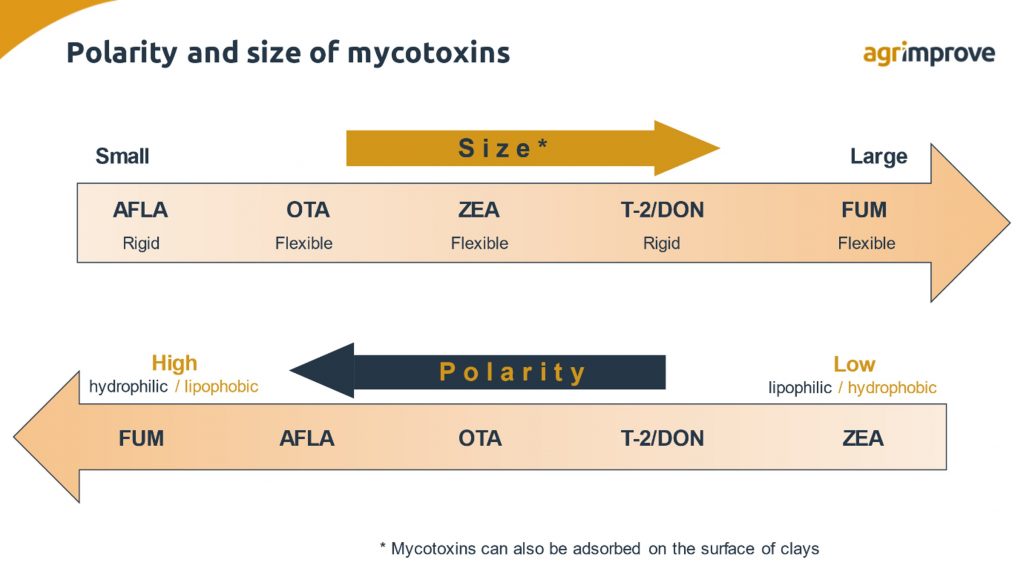For a long time, mycotoxins—and their effects on humans and animals—have been identified and extensively described. In the late 1950s, aflatoxin was the first mycotoxin considered a threat to animals (particularly poultry), and later, other mycotoxins were added to the list of dangerous toxins: ochratoxin, T2, DON, zearalenone, and most recently fumonisin.
Since aflatoxin was the initial mycotoxin to pose risk to animals, early mycotoxin binders targeted aflatoxin. In general, the commercial products against this mycotoxin were based on natural clays. Different kinds of clay were considered: bentonites, zeolites, sepiolites, etc.
The criteria to consider these clays as candidates for mycotoxin binders was their affinity to bind aflatoxin and not to interfere with (bind) the other micro-ingredients of the diet (minerals, vitamins, amino acids, etc.). With time, bentonite emerged as the best candidate among the natural clays to fulfill both requirements, as it has a high affinity for aflatoxin and does not bind to dietary ingredients.
As the awareness of other mycotoxins impacting animal production grew, it became evident that natural clays were not ideal candidates to bind all mycotoxins. There are several factors that make each mycotoxin more or less susceptible to binding:
In contrast, the factors that make different binders more efficient at capturing mycotoxins are:
For example, aflatoxin is a very polar mycotoxin that is small in size and has a planar (flat) molecular structure. These traits made it the ideal candidate to be captured by different binders. Another example, fumonisin is also polar but it is larger with a branched molecular structure—that actually can vary in shape depending on the presence of lipids—so its affinity to different binders is much less than aflatoxin.

When the industry faced the challenge to bind/destroy multiple mycotoxin varieties, different technologies were evaluated and applied.
This approach maintains the concept of mycotoxin binding as the mechanism of action. These solutions bind to different mycotoxin molecules and, in doing so, partially modify the characteristics of the original natural clay. To help the clay bind to different molecules better, it can be modified to target a broad spectrum of mycotoxins. An added benefit is—because the product maintains its inorganic nature—it will not be damaged when exposed to the heat often present in different feed manufacturing procedures (pelleting, extrusion, etc.).
The best example of this category is yeast cell wall fractions. The mechanism of action is the same as clays with aflatoxin. Before the mycotoxin is absorbed by the gastrointestinal, the organic binders unite with the mycotoxin and excrete the binder-mycotoxin complex via the feces. The rationale behind these products is that their chemical composition makes them better suited to bind different mycotoxin molecules.
Data seems to indicate they have some binding capacity but at low levels of mycotoxin contamination. It is also debatable if their mode of action is due to binding or their role as an immune stimulator that compensates for the immunosuppression caused by different mycotoxins.
The thought process behind these products is some mycotoxins molecules cannot be bound effectively and the best approach is to destroy the molecule. Each enzyme/bacteria is designed to target a specific mycotoxin. Enzymes are a scientifically sound approach, but their primary limitation is price and production/supply-chain issues (e.g. lower efficacy when exposed to heat during feed treatments such as pelleting, extrusion, etc.).
As with any additive, evaluate the data provided by the manufacturer of the different products to find the best option for your operation. The groups mentioned above are general approaches to fighting mycotoxins, but the products must provide scientific evidence to demonstrate their efficacy.
Would you like to be kept informed of our latest developments? Register here and stay up to date.
"*" indicates required fields
| Cookie | Duration | Description |
|---|---|---|
| cookielawinfo-checkbox-analytics | 11 months | This cookie is set by GDPR Cookie Consent plugin. The cookie is used to store the user consent for the cookies in the category "Analytics". |
| cookielawinfo-checkbox-functional | 11 months | The cookie is set by GDPR cookie consent to record the user consent for the cookies in the category "Functional". |
| cookielawinfo-checkbox-necessary | 11 months | This cookie is set by GDPR Cookie Consent plugin. The cookies is used to store the user consent for the cookies in the category "Necessary". |
| cookielawinfo-checkbox-others | 11 months | This cookie is set by GDPR Cookie Consent plugin. The cookie is used to store the user consent for the cookies in the category "Other. |
| cookielawinfo-checkbox-performance | 11 months | This cookie is set by GDPR Cookie Consent plugin. The cookie is used to store the user consent for the cookies in the category "Performance". |
| viewed_cookie_policy | 11 months | The cookie is set by the GDPR Cookie Consent plugin and is used to store whether or not user has consented to the use of cookies. It does not store any personal data. |
